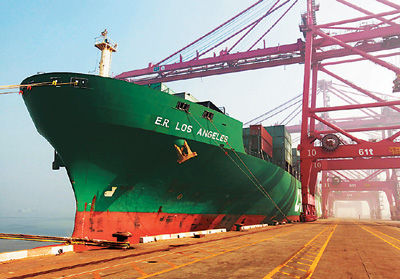China to Become Dominant Force in Global Economic Growth

According to data from the third quarter of 2010, China's economic growth rate stood at 9.6 percent, which means the rate has begun to slow. The International Monetary Fund said China's economic growth accounts for almost one-fifth of the world total, and China's purchasing power is only one-fourth of the world total.
In 2009, China accounted for 46 percent of the world's total consumption of coal, aluminum and zinc and the consumption of the crude steel was twice as much as the total of the European Union, the United States and Japan, according to figures released by the World Coal Institute.
In addition, demand for mobile phones in China will exceed the combined demand of all other countries in the world.
Global exports to China increasing
Since the global financial crisis, China's market demand has boosted the economic recovery of neighboring countries and even the world, especially in driving the rapid price rebound of bulk products, such as crude oil and iron ore, according to the General Administration of Customs.
In the first three quarters of this year, the price level of imports of primary products saw an increase of 37 percent and the actual volume of imports grew nearly 24 percent after discounting price rises, which is significantly higher than that of other major economies, and they are more dependent on China's imports.
Yao Jian, spokesman of the Ministry of Commerce, said recently that China has become a key export market for many countries. China was the largest export market of Japan, Australia, South Korea, ASEAN, Brazil and South Africa and the third of the United States and the European Union and India. And the proportion of China's exports to these countries will see growth at different levels.
China strives to reduce trade surplus
China has realized the importance of imports and its policy has gradually transferred from encouraging exports and restricting imports to advocating trade balance, an expert told the overseas edition of People's Daily.
Chinese government facilitated the customs clearance in imports in 2010.
In the commodity structure, before the 2008 financial crisis, the industrial raw materials and capital goods had a higher share in China's imports. While in 2010, for the purpose of balanced trade, imports of autos and spare parts saw a higher growth, most of which were imported from the United States, Europe and developed countries. It was helpful in addressing bilateral trade imbalance.
As of October 2010, the exports and imports volume amounted to 2.4 trillion U.S. dollars, an increase of 36 percent from the same period of last year, of which, exports account for 1.3 trillion U.S. dollars, up 33 percent and imports make up 1.1 trillion U.S. dollars, growing 41 percent.
The growth rate in imports is higher than that of exports, which is helpful to reduce trade surplus as well as ease the pressure of RMB appreciation.
China's role is crucial
Analysts say China's timely economic stimulus policies ensured domestic economic stability and development since the 2008 financial crisis. While suffering the impact of the global recession, China still achieved rapid economic growth.
The economic growth led to the high demand for capital goods and industrial products. China's imports of these goods play significant role in promoting exports for the developed countries and newly-industrialized countries.
In addition, China's demand for a large number of raw materials due to its industrialized production is good news for the exports-oriented and resource-dominated developing countries.
China's rapidly economic growth played crucial role in the current world economic environment, and China will become the dominant force in global economic growth in the future, said the World Economic Forum President Klaus Schwab in a speech.
News&Opinion
 more
more- China to Become Dominant Force in Global Economi...
- Small Businesses Boost Wenzhou
- Chinese Cool on Report Calling Shanghai Students...
- Senior Chinese Official Stresses Change of Growt...
- Chinese Wind Power Ready for International Market
- Solar Energy Widely Used in SW China's Yunnan
- 2011 Harbin Ice and Snow Festival to Open
- Beijing strives to improve health care for forei...
Policy&Laws
China Makes Great Contributions to MDGs
Since global leaders established the Millennium Development Goals (M...
China, Singapore Swap "Young Business Ambassador...
9:16:44 September 14, 2010 Eight "young business ambassadors" fro...
Alibaba to Help U.S. Students in E-commerce Job ...
HANGZHOU, Sept. 11 (Xinhua) -- Alibaba Group, China's largest e-comm...





 print
print  email
email  Favorite
Favorite  Transtlate
Transtlate 







